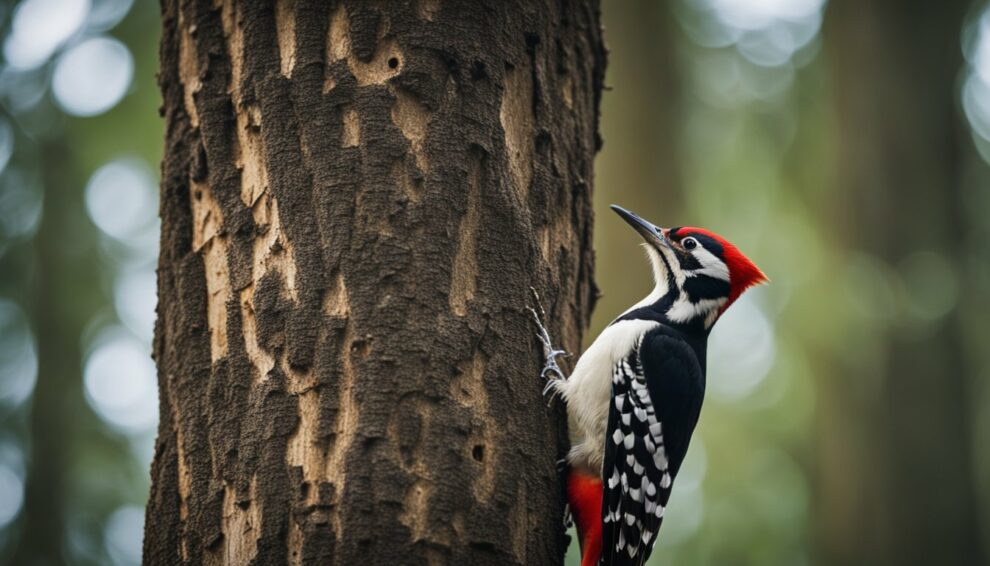Woodpeckers are known for their unique drumming ritual.
The drumming is not just a random act, but a form of communication that helps them establish territory and attract mates.
Woodpeckers are known to peck on objects to create sound patterns as communication.
Resonant objects such as hollow trees, logs, and stumps are favored for drumming because their resonance increases the strength and volume of the drumming so it can be heard further away.

The drumming ritual is more than just a territorial display; it is also a way for woodpeckers to communicate with each other.
Woodpecker pairs will have begun their courtship at the end of winter, a ritual that involves the male drumming his beak against hollow wood 10 to 20 times in just 2 seconds.
This serves to mark his territory and alert a female to his presence.
Females will also drum briefly to make themselves known when entering a male’s territory.
The tempo, length, tone, and rhythm of drumming varies widely between species.
Woodpeckers offer a fascinating cast of drummers.
Some, like the Northern Flicker, make a loud, rolling rattle with a piercing tone that rises and falls in volume several times.
Others, like the Pileated Woodpecker, let go a resounding tattoo against a hollow trunk.
The drumming can be heard from far away, making it an effective way for woodpeckers to communicate with each other.
As such, the drumming of woodpeckers is a unique and fascinating aspect of their behavior that is worth exploring further.
The Language of Woodpeckers
Woodpeckers are fascinating creatures that use drumming as a means of communication.
They are known for their unique behavior of tapping on trees to produce a rhythmic sound that can be heard over long distances.
This drumming behavior is not only for territorial signaling but also for attracting mates.
Patterns and Purposes of Drumming
Woodpeckers have different patterns of drumming that serve different purposes.
Some species produce short, fast drumming patterns, while others produce longer, slower patterns.
The frequency and volume of the drumming can also vary depending on the purpose of the communication.
For example, woodpeckers may produce a loud and rapid drumming pattern to announce their territory to other birds, while a softer and slower pattern may be used to attract a mate.
Deciphering the Drumming Code
Deciphering the drumming code of woodpeckers can be a challenging task.
However, scientists have been able to identify some of the common patterns and meanings behind the drumming behavior.
For instance, woodpeckers may use a series of short bursts to signal their presence in a particular area, or a longer, more complex pattern to indicate a specific message.
Woodpeckers also use a range of other calls and vocalizations to communicate with each other.
These include chirps, whistles, and squawks. Each call has a different purpose and meaning, and is used in different situations.
In conclusion, the drumming ritual of the woodpecker is a fascinating example of avian communication.
By tapping on trees, woodpeckers are able to produce a range of sounds that serve different purposes, from territorial signaling to mate attraction.
Understanding the language of woodpeckers can help us appreciate the complexity and diversity of the natural world.
Anatomy of a Drummer

Woodpeckers are fascinating creatures with unique physical adaptations that enable them to drum on trees with incredible speed and precision.
In this section, we’ll explore the anatomy of a drummer, from bill to tail, and learn how their brains and bills work together to create the drumming machine.
Bill to Tail: Physical Adaptations
Woodpeckers have several physical adaptations that make them excellent drummers.
Their bills are long, straight, and chisel-like, with a sharp tip that can peck through tough bark and wood.
The bill is also reinforced with a special bone structure that acts as a shock absorber, protecting the brain from the impact of pecking.
Their feet are also uniquely adapted for climbing trees.
They have two toes pointing forward and two toes pointing backward, which allows them to grip the bark tightly and move up and down the tree trunk with ease.
Their tail feathers are stiff and pointed, providing balance and stability as they drum.
Brains and Bills: The Drumming Machine
Woodpeckers are not only physically adapted for drumming, but they also have unique brain structures that allow them to perform this behavior.
When a woodpecker drums, it is not just hitting the tree with its bill, but it is also rapidly moving its head back and forth.
This movement is made possible by a special neck structure that allows the woodpecker to rotate its head up to 270 degrees without damaging its spinal cord.
The woodpecker’s brain is also specially adapted for drumming.
They have a thick skull and a small brain, which allows for more efficient energy transfer when pecking.
Additionally, their brains have a higher density of neurons, which allows them to process sensory information quickly and make split-second decisions.
In conclusion, woodpeckers are fascinating creatures with unique physical and physiological adaptations that enable them to drum on trees with incredible speed and precision.
Their bills, feet, tail, neck, and brain are all perfectly suited for this behavior, making them one of nature’s most impressive drumming machines.
The Daily Life of Woodpeckers

Woodpeckers are fascinating creatures that are known for their drumming rituals and unique feeding habits.
They are diurnal, which means they are active during the day and rest at night.
In this section, we will explore the daily life of woodpeckers, including their behavioral patterns and quest for food.
From Dawn Till Dusk: Behavioral Patterns
Woodpeckers are early risers, and they start their day at dawn. They spend the first few hours of the morning foraging for food and tapping on trees.
They are highly active during this time, and their drumming can be heard from miles away.
As the day progresses, they become less active and spend more time resting.
Woodpeckers are solitary birds, and they spend most of their time alone.
However, during the breeding season, they form pairs and engage in courtship rituals.
They also communicate with each other through a variety of calls and drumming patterns.
Diet and Foraging: The Quest for Food
Woodpeckers are insectivores, which means they feed primarily on insects.
They have a unique feeding habit, and they use their sharp beaks to drill holes in trees to extract insects.
They also eat fruits and nuts, especially during the winter months when insects are scarce.
Woodpeckers are highly skilled foragers, and they have developed a variety of techniques to find food.
They tap on trees to locate insects and listen for the sound of their movement.
They also use their sense of smell to detect insects hiding in crevices and under bark.
Woodpeckers play an important ecological role in forest ecosystems.
They help control insect populations, which can have a significant impact on the health of trees.
They also create cavities in trees, which provide nesting sites for other birds and animals.
In conclusion, woodpeckers are fascinating creatures that have developed unique adaptations to survive in their environment.
Their drumming rituals and feeding habits are a testament to their ingenuity and resilience.
Conservation and Coexistence

Protecting Woodpecker Habitats
Woodpeckers are fascinating creatures that play an important role in the ecosystem. However, habitat loss is one of the major threats to their survival.
As trees are cut down for development and agriculture, the woodpeckers lose their homes and food sources.
It is important to protect their habitats by preserving forests and woodlands.
Land management practices can also be used to create suitable habitats for woodpeckers.
Dead trees and snags are important for woodpeckers as they provide nesting sites and food sources.
Land managers can leave dead trees standing or create artificial snags to provide suitable habitats for woodpeckers.
Living with Woodpeckers: Human-Woodpecker Dynamics
Woodpeckers are known for their drumming, which is a form of communication.
However, this drumming can sometimes be a nuisance to humans, especially when they drum on buildings or other structures.
To coexist with woodpeckers, it is important to understand their behavior and needs.
Providing alternate drumming sites away from buildings can help redirect their drumming behavior.
Covering the drumming site with padding can also help reduce the noise.
It is also important to avoid disturbing woodpecker nests during breeding season.
Woodpeckers are protected by law, and it is illegal to harm or disturb them or their nests.
In conclusion, conservation and coexistence are important for the survival of woodpeckers.
Protecting their habitats and understanding their behavior can help ensure their survival for future generations to enjoy.
Frequently Asked Questions

How do woodpeckers use their drumming to find a mate?
Woodpeckers use drumming as a way to attract a mate.
The male woodpecker will drum his beak against hollow wood, creating a loud and distinctive sound that can be heard from far away.
By doing this, he is marking his territory and alerting a female to his presence.
The female woodpecker will also drum briefly to let the male know she is interested.
Can you describe the difference between drumming and drilling behavior in woodpeckers?
Drumming and drilling are two different behaviors that woodpeckers use.
Drumming is a rapid and repetitive tapping of the beak against a resonant object, such as a tree trunk or a hollow log.
Woodpeckers use drumming to communicate with each other and to establish their territory.
Drilling, on the other hand, is a slower and more deliberate pecking of the beak into wood.
Woodpeckers use drilling to excavate nests and to find food, such as insects and larvae, inside trees.
What time of year do woodpeckers typically engage in their drumming rituals?
Woodpeckers typically engage in their drumming rituals during the breeding season, which varies depending on the species and the location.
In general, woodpeckers start drumming in early spring, when the days start to get longer and the weather begins to warm up.
Drumming is most common in the morning and late afternoon, when the light is dim and the woodpeckers are most active.
In what ways do woodpeckers use drumming to establish territory?
Woodpeckers use drumming to establish territory in several ways.
First, they use it to communicate with other woodpeckers and to let them know that a particular area is already occupied.
Second, they use it to attract a mate and to defend their mate from other males.
Third, they use it to intimidate other animals, such as squirrels and other birds, that might try to invade their territory.
Is the rhythm of woodpecker drumming significant, and if so, how?
Yes, the rhythm of woodpecker drumming is significant.
Different species of woodpeckers have different rhythms and patterns of drumming, which can be used to identify them.
For example, the downy woodpecker has a slower drumming pattern than the hairy woodpecker.
The rhythm of the drumming can also convey information about the woodpecker’s mood and intentions.
For example, a woodpecker that is drumming rapidly and aggressively might be trying to defend its territory from an intruder.
What other signals do woodpeckers use in combination with drumming to communicate?
Woodpeckers use a variety of signals in combination with drumming to communicate with each other.
These include calls, visual displays, and body language.
For example, woodpeckers will often call out to each other before they start drumming, to let other woodpeckers know that they are about to start.
They will also use visual displays, such as spreading their wings or puffing up their feathers, to signal their intentions.
Finally, they will use body language, such as tilting their head or fluffing their crest, to convey their mood and intentions.









